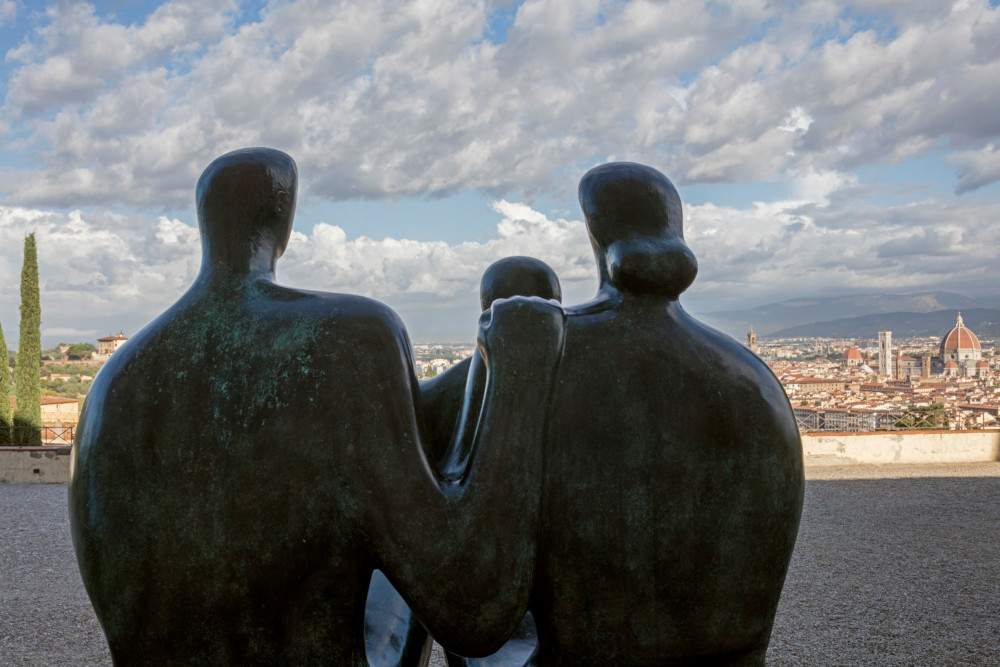Henry Moore returns to Florence. The city pays tribute to the artist with two exhibition projects
The Museo Novecento presents, on the occasion of Florence Art Week, Henry Moore in Florence and Back to Moore. Forte Belvedere 1972. Fifty years after the 1972 exhibition at Forte Belvedere, Henry Moore (Castleford, 1898 - Perry Green 1986) returns to Florence: the city pays homage to the English master with a project realized thanks to the renewed collaboration with the Henry Moore Foundation and BIAF - Biennale Internazionale dell’Antiquariato di Firenze.
Curated by Sebastiano Barassi and Sergio Risaliti, the Henry Moore in Florence exhibition project presents two significant monumental works of Henry Moore’s great sculptural production from September 16, 2022 to March 31, 2023: Large Interior Form and Family Group will be exhibited respectively in Piazza della Signoria and on the Churchyard of the Abbey of San Miniato al Monte. Two subjects dear to the artist recur in the two works Family Group and Large Interior Form: the human figure and theexercise of form between solids and voids.
Henry Moore began making Family Group in 1934, when architect Walter Gropius asked him to create a sculpture for a new school. The work was not completed until after World War II, sometime between 1948 and 1949, when it was installed at Barclay School in Stevenage, England. It was the artist’s first life-size sculpture to be cast in bronze. In the postwar period, when a wave of reconstruction took hold in Britain, Moore was asked to make several public sculptures. His interest in the human figure, which became central to much of his production, was developed in the aftermath of the tragic war events that had convulsed the world, with a desire to counter the dehumanizing effects of war. Family Group, metaphorically inspired by the birth in 1946 of the artist’s only daughter Mary, portrays an idealized family unit in which two adults mirror each other while the infant, the pivot of the composition, binds them together forming a central knot. Today this group is exceptionally housed in a symbolic place in Florence, the churchyard of the Abbey of San Miniato al Monte, which dominates the city from above.
A few years later, Moore began working on another theme, the contrast between fullness and emptiness. With Large Interior Form (1953-54) the artist investigated sculptural relationships on a formal level, presenting one form within another. The sculpture, in fact, saw the light of day as the “interior form” of a larger work, Large Upright Internal/External Form, of the same year. As he often did, Moore took a portion of an existing work and used it as a starting point to develop a new sculptural idea. The presence of large open forms underscores the organic three-dimensionality, a suggestion derived from some pebbles found on the seashore. The twisting and asymmetry of the upright form is reminiscent of the counterpoint of classical sculpture, an echo perhaps of the great influence Renaissance art had on Moore throughout his career. And it is precisely with the great Florentine sculptural tradition that Large Interior Form, placed in a privileged spot in Florence’s Piazza della Signoria, dialogues today.
In conjunction with Henry Moore in Florence, the exhibition Back to Moore. Forte Belvedere 1972 that will present historical images collected from the personal archives of all those who, from all parts of Italy, visited the exhibition that has remained in history. A project conceived by Sergio Risaliti that offers a collection of memories collected by the Novecento Museum through a contest launched in local newspapers and continued on social channels, which will allow people to relive that event so emblematic for the city of Florence, for art and for the community.
For info: www.museonovecento.it
Photo by Serge Domingie
 |
| Henry Moore returns to Florence. The city pays tribute to the artist with two exhibition projects |
Warning: the translation into English of the original Italian article was created using automatic tools. We undertake to review all articles, but we do not guarantee the total absence of inaccuracies in the translation due to the program. You can find the original by clicking on the ITA button. If you find any mistake,please contact us.





























